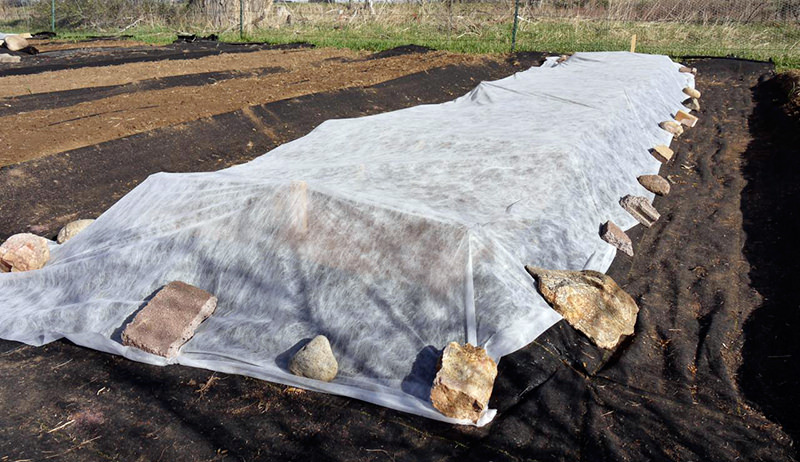
Row cover is most commonly associated with protecting crops from cold, but its utility hardly stops there. Over the years, we have learned to use various densities of row cover in our gardens in many different ways. Some may seem obvious, but other ways we use basic row covers may surprise you. Buying row cover is an expense, and it can be a headache to pull on and off for cultivations and to get to your crops, but in our experience this product has proved invaluable. It helps in the fields, and always pays off at the market table.
Field Gemination Chambers
Every spring, we use a heap of row cover in our gardens. We have found that because it has the ability to trap some moisture and retain some heat, row cover will increase the soil temperature enough to germinate crops more rapidly. How it works is that we will prepare some ground, seed a crop and place the light row cover flat against the soil, secured with dirt, rocks, sandbags or whatever you have handy. Ultimately, this reduces the amount of transplantation we need to do, and grows crops faster in the spring so we are often the first to our markets with things like spinach, lettuce, radishes, turnips and other direct-seeded crops.
“Scarecrow”
One place we never neglect to use row cover is in our sweet corn. We will soak the sweet corn, seed it and then cover the beds with a light row cover. Then we will allow it to germinate and penetrate the soil before removing the row cover once the corn reaches about 6 inches tall. The young corn is sturdy and will have no problem pushing the row cover off of the ground. The goal here is to help prevent crow damage, and it has always worked for us.
However, crows are smart and may dig through the row cover to get to the sweet corn, so the use of a secondary “scarecrow” is still not a bad idea. Row cover may also help protect your crops from rabbits, squirrels and deer, though deer may paw through it if they want something inside. Generally, we have found this not to be the case, but it is technically possible. That said, keeping your crops out of reach of larger pests will increase yield and ultimately sales.
Pest Protection
Few things can compromise the salability of a crop quite like a pest littering it with tiny bites—it is hard to sell half-eaten kale or arugula with a million flea beetle holes. However, throw some light row cover or inset barrier (aka really light row cover) overtop of a crop to help keep it looking crisp and pristine for the market table.
Disease Protection
Another reason it is important to keep pests off isn’t just for look, yield or longevity of the crop, but also for keeping disease off and from spreading. Pests like the cucumber beetle are adroit at transferring diseases, such as mosaic virus, from plant to plant. Row cover prevents the pest and thus the diseases which can cause wilting, discoloration, spots and ultimately poor yields.
Protection From Cold
Then, of course, is the obvious reason most of us already use row cover: frost protection. By throwing row cover over beds—and, notably, keeping it suspended above the crops so as not to touch the young leaves—you can keep crops from being killed by cold. Sometimes, depending on the density of the cover, the winter conditions and the farm location, some heavy row cover in the field can keep crops alive for well into the colder months. This will certainly be obvious at the market table when you are not only the first to market with lettuce or kale, but also the last to still have it.




